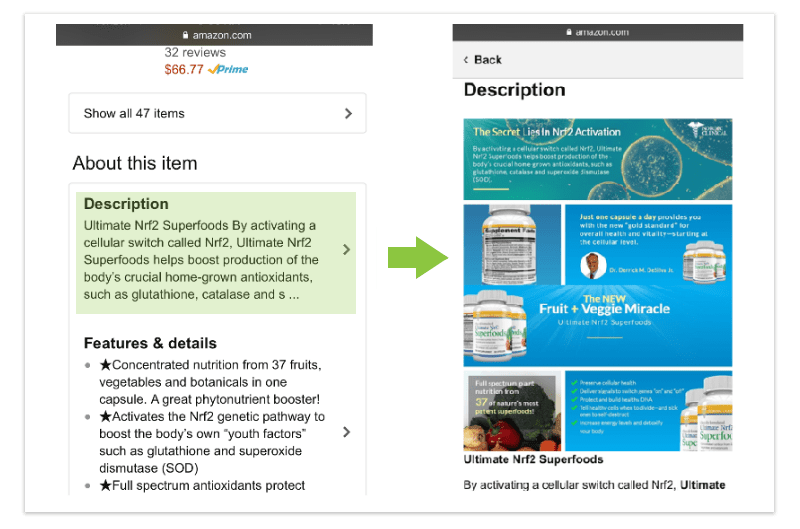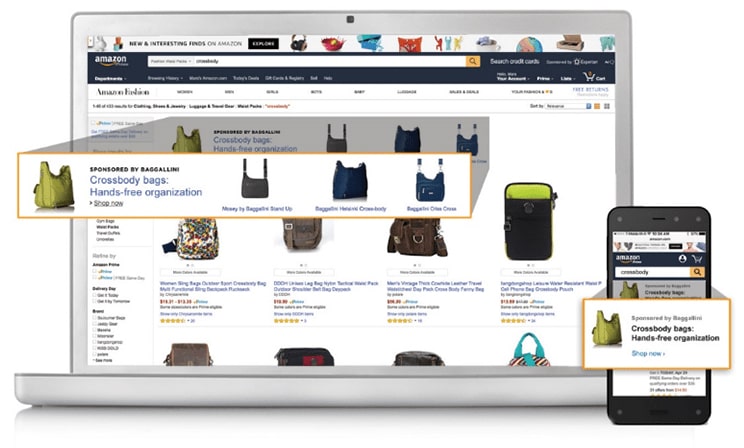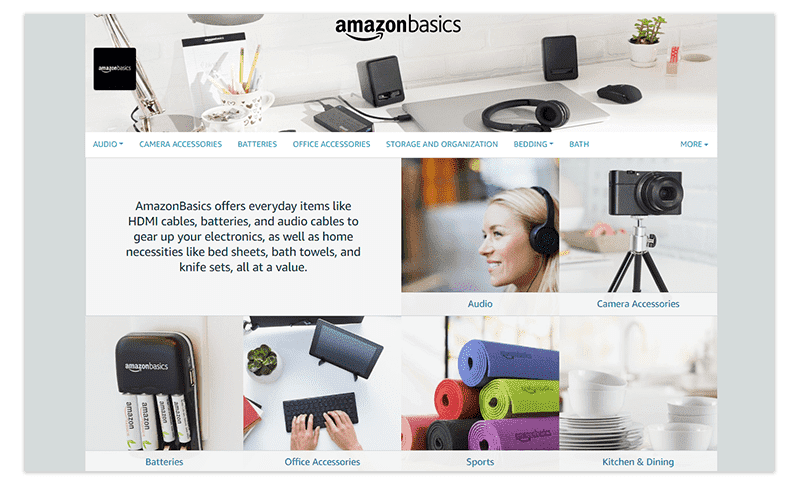
Top 5 Amazon Updates You Need to Know in 2017
It seems that Amazon adds amazing features to their sites, apps, and devices every week. From upgrading seller marketing abilities to storefront redesigns, 2017 has been the year of rapid-fire innovation for the e-commerce giant. Among their many software and website updates, here are the top 5 that marketers can’t afford to miss.
Amazon Sellers Will Soon Be Able to Add Videos To Their Product Listings
It’s no secret that video is the future of digital marketing. According to Forbes, 90% of users say product videos are helpful when making the decision to buy, and the inclusion of a video can increase conversion rates up to 80%. With 64% of users more likely to buy a product online after watching a video, product videos are increasingly more important. E-commerce platforms across the web are quickly learning that product videos are crucial to competing for online market share.

How Amazon is Including Product Videos
If you’re a Fulfillment by Amazon (FBA) Seller or Enhanced Brand Content user, you may be able to add a video to your product listing pages soon. Previously, the ability to use Enhanced Content such as videos in detail pages were limited to approved Vendors in the Vendor Express program. However, now Amazon and a select few sellers are currently testing video in Beta, and it will soon be available on Amazon Seller Central for third-party sellers. The video will display in the main image block on a product detail page, and it will also appear in the Amazon’s “Related Video Shorts” section on the detail page.
Tips from Amazon to Video Beta Testers:
- Follow all of the EBC Video Guidelines
- Uploads must include video file, image thumbnail, video title, and video descriptions
- If video contains content that is unsuitable for minors, then select the adult audience box
Video Specifications:
- Upload the video in either 3GP, AAC. AVI, FLV, MOV, MP4, AND MPEG-2.
- Upload thumbnail images in either JPEG or PNG format with an aspect ratio of 16:9 and resolution of 1920×1080
- Video title of 100 characters max, description of 400 characters max, and ASINs are required
Customers also report they have more confidence in the brand and the products they are considering buying after viewing a product video. 51% of those users are also less likely to return those products after purchase. With product ratings being so important to success on Amazon, adding video should help in that department as well. Overall, video content is more attention-grabbing, builds more trusts from the consumer, and allows the seller to display their products in a unique, engaging way resulting in better product performance and conversions.
Enhanced Brand Content and A+ Pages Now Visible on Mobile
Like video, mobile is completely unignorable when it comes to online marketing or advertising. Data shows that just last year mobile internet usage surpassed desktop usage for the first time. As mobile devices continue to act more like desktop computers, consumers are relying more and more on them to access information anytime, anywhere. Just last holiday season, Amazon reported that more than 72% of their customers shopped using a mobile device. Needless to say, optimizing for mobile is crucial.
Amazon Includes Enhanced Brand Content (EBC) and A+ Pages on Mobile
Thankfully, the online company has taken the initiative to make some EBC and A+ Pages visible on mobile screens. Prior to this update, Amazon hid all EBC and A+ Pages from mobile shoppers unless they clicked into the product description. Now, both can appear just below the “About this item” headline.

EBC and A+ Pages allow a seller to include a unique brand story, unique value proposition, enhanced images, and text placement. According to Amazon, products with EBC report an average of 3-10% increase in sales due to SEO relevance, and customer purchase confidence. As you gear up for the holidays, keep in mind the ever-growing need to optimize for mobile and shopping apps. The Amazon app alone reported a 56% increase in app shopping for the 2016 Holiday season, and that number is only set to climb.
Amazon Headline Search Ads Now Available in Seller Central
One of the larger updates this year happened in August. Headline Search Ads, an ad type that was once reserved exclusively for Vendors in Amazon Marketing Services (AMS), has recently become available for third-party Sellers.

What is a Headline Search Ad?
AMS has 3 ad types available to vendors: Sponsored Search, Headline Search, and Product Display Ads. Headline Search Ads (HSA) appear just below the top navigation, and above the products listings. Targeting works by choosing keywords and setting bids similar to manual sponsored product search ads. They have more creative flexibility in that you can include a custom headline title, your brand or company’s logo, the name of your brand, and either three similar or complementary products. The implementation of HSAs could greatly impact your Amazon brand by:
Increasing Conversions
Since these ads are served at the top of the search results, a seller can reach the consumer at the beginning of their purchase process.
Increasing Average Order Value/Revenue
Unique to HSA, a seller can cross-sell up to three different products in one single ad. Depending on where in the ad the user clicks, they are taken to either a catalog list of all the products featured or to the product page of a specific item. Amazon reported that at least 35% of its revenue in a single year was due to cross-selling.
Providing Creative Control
Unlike some ad types within Amazon, HSA allows you to write up your own ad title. There are some limitations, however, including restraints on using imperatives such as “#1 best selling”.
Provide In-Store Experience with Amazon Storefronts Available to Third-Party Sellers
Brand-owning sellers can now create immersive virtual shopping experiences with personalized Amazon Storefronts. Much like it sounds, these pages act as a brand’s own store within the Amazon realm. Brand owners have multiple ways to set up their store with either provided mobile and desktop templates or completely customizable options with their own personal URL (www.amazon.com/your brand).

Benefits of Amazon Storefronts
Much like having your company’s own website, Amazon Storefronts help drive user engagement to not only entice them to shop your products, but also help them learn more about your brand as a whole and build consumer trust. These stores also offer integrated promotion options such as social share buttons and extensions such as HSAs to drive brand awareness. The store customization features include 3 templates such as Product Grid, Marquee, and Showcase that tend to the needs of each individual brand. If you prefer to build your store from the ground up, the Store Builder tool empowers brand owners to create their own stores in minutes and have them live within 72 hours. The tool is simple to use with no prior web design experience necessary.
Amazon Launches Advertiser Audiences
As of June, Amazon Advertising Platform offers a self-serve audience platform that lets advertisers access audience matching, similar to tools available on Google and Facebook. The tool allows brands to build audience segments based on data directly from Amazon.

Source: advertising.amazon.com
One interesting thing to note about this tool is that it is available to all digital marketers, including those whose clients or brands do not sell products or services on Amazon.com. The audience tool can help advertisers reach a number of customers including existing, lookalike, and new customers.
Existing Customers
Reaching existing customers allows advertisers to drive relevant traffic by accessing customers you already know are interested in your brand. In early studies of Amazon Audiences, reaching existing customers increased CTR by 2x and purchase rate up to 8x.
Lookalike Customers
Reaching customers who behave similarly online to your existing customers can increase traffic to your product page on Amazon by 200%. Lookalike customers are also 4x more likely to purchase after reaching the appropriate landing page.
New Customers
Exclude existing and lookalike customers from a campaign to focus on gaining new customers. In one early case study, segmenting existing customers from a new customer campaign prevented redundancy which helped achieve a 5% to 10% reduction in wasted ad spend.
Studies show brands that use audience segmenting increase ROAS up to 8x campaign averages, and unlike audiences on Facebook, Amazon audiences are likely further down the purchase funnel and more likely to convert. Therefore, messaging can be more aggressive than informational campaigns found on other platforms. Behavioral customer insight from Amazon could also influence future digital advertising decisions, even on non-Amazon campaigns.
TL;DR
Amazon has been focusing heavily on updates designed for advertisers and marketers. Earlier this year, the online marketplace released some features to third-party sellers that were formerly just available to vendors such as personalized Storefronts, Headline Search Ads, and product page videos, a feature currently in Beta. Aiming to become more mobile-friendly, Amazon has also allowed Enhanced Branded Content and A+ Pages visible on mobile devices. Lastly, Amazon Audiences has now been made available to all online advertisers. This tool allows for audience segmentation for existing, lookalike, and new customers.




